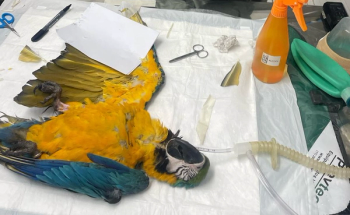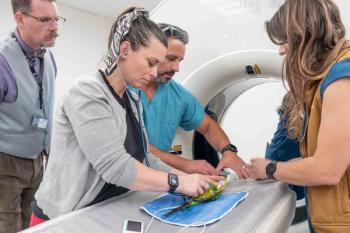
Diagnostic imaging considerations for reptiles (Proceedings)
Diagnostic imaging is an underutilized resource in herpetological medicine.
Diagnostic imaging is an underutilized resource in herpetological medicine. Survey radiographs and ultrasound can be used to evaluate many different systems simultaneously, and provide insight into possible problems in a case. To be successful with diagnostic imaging, veterinarians need to acquire a basic knowledge of anatomy regarding the species of interest, methods used to restrain reptiles to collect the images, and the most appropriate techniques used to collect and interpret the results.
There are a variety of resources available to the veterinarian that is trying to learn more about reptile diagnostic imaging. Mader's Reptile Medicine and Surgery (Elsevier/Saunders, 2006) provides an excellent review on the subject. Expert opinions can be obtained either via phone consults or via the internet (e.g., Veterinary Information Network). There are also board certified radiologists that offer consultation services. Regardless of the source, veterinarians have many options when attempting to interpret the findings of a diagnostic image
With over 7,000 different species of reptiles, it is impossible to become comfortable with the anatomic peculiarities of all the reptiles. Fortunately, reptile anatomy is highly conserved among the orders. For simplicity, the reptiles can be categorized into one of four groups: chelonians, lizards, snakes, and crocodilians. The tuatara is not mentioned because it is not considered a common captive reptile. Reptile morphology texts are excellent resources for learning the anatomy of these animals. Short descriptions can also be found in Reptile Medicine and Surgery (Mader, Elsevier/Saunders, 2006) and Clinical Anatomy and Physiology of Exotic Species (O'Malley, Elsevier/Saunders, 2005).
The quality of the equipment used to take radiographs is an important consideration. A radiographic machine to be used for reptiles should be capable of a taking a range of images, which might include day geckos (Phelsuma spp.) to varanids (komodo dragons, Varanus komodoensis). A machine capable of such a range should have a short exposure time. 1/60th of a second or shorter is recommended. The machine should also have a high milliamperes capacity (>300). This is important because of the variability in detail that might be expected among different sized animals. The killivolt peak range should also be large, 40-100 killivolt peak, to accommodate the different sized patients a veterinarian may encounter. The ability to alter the killivolt peak by small increments (e.g., 2 killivolt peak) is important because it will enable the veterinarian to review small details between images. A machine in which the tube can be rotated to provide a horizontal beam is preferred. This will enable the veterinarian to take lateral images on animals in sternal recumbency. This is especially important with large chelonians.
For small patient, dental radiograph machines can be used. The author has used this type of equipment to take "whole body" radiographs of small lizards (e.g., juvenile bearded dragons). The detail from these images, although not always refined, does provide more detail than standard films.
Selecting the correct type of cassette or film is as important as using the correct machine. High-detail, rare earth cassettes are preferred. These cassettes should be used in combination with slow speed, single emulsion (gray) films. This combination provides the best detail for small lizards. Double emulsion (black) films can be used for larger reptiles when small detail is not required. Selecting the correct size cassette and film combination is also an important consideration.
When taking radiographs it is important to always collect at least two images. The most common images are a lateral and dorsoventral or ventrodorsal image. These two, two-dimensional images will provide the most insight into interpreting the anatomy of a three-dimensional reptile. Care should be taken when positioning an animal to ensure that the area of interest can be evaluated.
A reptile must be still to collect the "perfect" image. Taking radiographs on un-anesthetized or restrained reptiles can lead to motion and a loss of detail. The author has found that reptiles can be restrained manually for images or anesthetized. Manual restraint does result in increased radiation exposure for the handlers, so it should be kept to a minimum. Placing blinders over the eyes of a lizard can also be done to minimize movement. The author has found this technique to work well with iguanas, bearded dragons, and varanids. An ophthalmic eye lube is placed in the eyes of the animal and the head is wrapped with vet-wrap (3M products, St. Paul, MN). Dimming the lights and minimizing human movement and speaking in the room will also help reduce the stimuli on the reptile.
Interpreting reptile radiographs is more challenging than in mammals or birds. Lizards do not store their fat in a mesentery like mammals. This absence of fat between the internal organs reduces the contrast between the tissues, leading the viscera to appear as a single soft tissue structure. The absence of a diaphragm also limits the radiographic interpretation of the coelomic structures. The bone of reptiles is less radio opaque than mammals, which can make the interpretation of the cortical densities more difficult. To reduce the likelihood of misclassifying a case of secondary nutritional hyperparathyroidism, the author always evaluates the cortical densities of the long bones instead of the digits. The best way to become comfortable with interpreting radiographs is to practice, practice, and practice.
As veterinarians have become more familiar with ultrasonography, its application in reptile medicine has greatly expanded. When considering an ultrasound machine for a veterinary hospital, it is important to consider the range of patients the machine will be used on. If exotic species are going to be regularly screened using ultrasound, than a machine with a fine transducer is recommended. The author has found that 7.5 and 10.0 mHz transducers are generally best for evaluating reptiles; however, 3 and 5-mHz transducers have also been used in larger species. One of the problems with using these lower mHz transducers is the loss of detail associated with upper surface lesions. Because of the relative small size of many of our reptile patients, the author also prefers the transducer to have a small footprint.
Capturing a high detail ultrasound image requires intimate contact between the transducer and the animal. There are two different methods for obtaining high quality ultrasound images: direct contact via a non-irritating coupling gel or direct/non-direct contact via an aquatic medium (e.g., water). Coupling gel is the most common method used for collecting ultrasound images in mammals. In reptiles, this technique can also be used, but it is important to spread the gel between the scales to reduce the loss of detail associated with trapped air bubbles. The transducer can also be placed against a water-filled examination glove that is directed against the reptile's body. This method is the least productive in the author's opinion. Another technique that many reptiles are tolerant of involves placing the animal and the transducer into water. The water acts as an excellent contact medium. The author works with a number of herpetoculturists that use this method for assessing the reproductive status of their reptiles.
Ultrasound can be used to evaluate any number of systems in a reptile. This diagnostic technique is primarily used by the author to assess the reproductive status of reptiles. Follicles can be measured to predict whether an animal is likely to ovulate. For some species this information can be used to determine the best time for introducing a male and female. Images of the ovaries are best obtained by placing the transducer on the lateral body wall just caudal to the last rib. Each ovary should be evaluated individually, as one gonad may be active while the other is not.
Ultrasound can also be used to evaluate the heart of reptiles. The heart of most lizards is located in the pectoral girdle, with varanids being an exception. Their heart is located more caudally in the body cavity. The snake heart is located approximately ⅓ the distance from the head. The chelonian heart is located dorsal to the thoracic scutes of the plastron. Access to the heart with ultrasound can be obtained via the axillary region in lizards and chelonians, and direct placement over the beating heart of a snake. Lizards, snakes, and chelonians have a three-chambered heart, while crocodilians are the only reptiles with a four-chambered heart. Rotating the transducer should enable the ultrasonographer to evaluate all three (or four) chambers.
Ultrasound can also be used to evaluate the viscera in the caudal coelomic cavity. The author generally uses ultrasound to assist with the collection of fine-needle aspirates or biopsies of different coelomic organs. Kidney disease is a common problem in captive, adult green iguanas. Iguana kidneys are located in the intra-pelvic canal in normal animals, but enter the coelomic cavity when enlarged. Ultrasound can be used to collect a percutaneous biopsy of these organs without the need for an exploratory coeliotomy.
Newsletter
From exam room tips to practice management insights, get trusted veterinary news delivered straight to your inbox—subscribe to dvm360.






